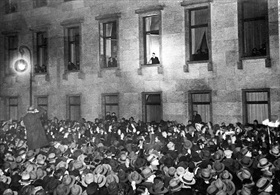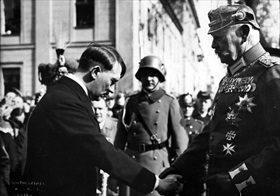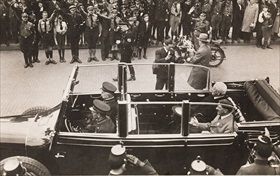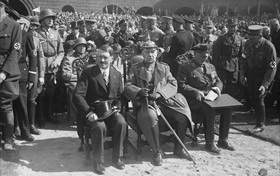HITLER APPOINTED GERMAN CHANCELLOR
Berlin, Germany · January 30, 1933
At noon on this date in 1933 in Berlin, German president and World War I hero Paul von Hindenburg appointed Adolf Hitler, an Austrian now with German citizenship, Reichskanzler of the Weimar Republic, a parliamentary representative democracy that had replaced the imperial form of government in 1919. Hindenburg reversed his earlier opposition to Hitler as chancellor, believing that at this moment in time the appointment could possibly end the political divisiveness and economic crisis that menaced the nation. The 85-year-old ex-General Field Marshal and the 43-year-old former corporal in the Kaiser’s army had first met each other 16 months before, when the outspoken, unconventional, and dynamic Hitler emerged as a political force to reckon with as leader of the increasingly popular National Socialist German Workers’ (Nazi) Party. In fact, in November 1931 Hitler became a candidate to replace the venerable Hindenburg as Reich President in the 1932 national elections, the year during which the Nazi Party emerged as the largest party in the Reichstag. Hindenburg decisively beat Hitler in the second round of voting on April 1, 1932. When Hitler was sworn in as the democratically elected chancellor of Germany on January 30, 1933, he was not yet Germany’s Fuehrer (“leader”). The concept of Fuehrer had been around for decades in Germany, arising out of the German Youth Movement of the early twentieth century. But Hitler rode the concept right to the center of national power in 1933. Within months of his election (commonly referred to as Machtergreifung, meaning “seizure of power”), Hitler began building on parliamentary statutes he had persuaded the elderly and ailing Hindenburg to put in place: He banned all political parties except his own and created a dictatorship in all but name. After Hindenburg’s death on August 2, 1934, Hitler consolidated the duties of president and chancellor, becoming Germany’s Fuehrer at the head of the Third Reich. (The Weimar Republic nominally existed until 1945 because the Nazis never formally repealed the Weimar constitution.) For the next 11 years, Hitler loosed a regime of serial violence, terror, misery, and genocide on Germany and half the world unparalleled in the twentieth century.
![]()
[amazon_carousel widget_type=”ASINList” width=”600″ height=”200″ title=”Recommended Reading” market_place=”US” shuffle_products=”False” show_border=”False” asin=”0312233515,0091917638,1845456807,140826921X,0143034693,0786439122,0531056333,1616086084,143919100X,0201328003″ /]
The Rise of der Fuehrer Adolf Hitler, 1930–1934
 |  |
Left: Newly appointed Chancellor Hitler at the window of the Reich Chancellery on Berlin’s Wilhelmstrasse receiving ovations on the evening of January 30, 1933. President Hindenburg (elected the second president of the Weimar Republic in 1925) was no admirer of Hitler and initially refused to name him chancellor. Instead, he appointed fellow army officer Maj. Gen. Kurt von Schleicher to the position. Political intrigue, cabinet crises, and backroom negotiations prompted an exasperated Hindenburg to end government instability by appointing Hitler to head a new cabinet and naming ex-Chancellor Franz von Papen as vice-chancellor, with the understanding that Papen would act as a “check” on Hitler’s more disturbing tendencies and encourage him to tamp down on the lawlessness and ruthlessness of the Sturmabteilung (SA), the Nazi Party’s paramilitary thugs.
![]()
Right: Hindenburg and Hitler on March 21, 1933, known as the “Day of Potsdam.” On that day the newly elected Reichstag was constituted with an opening ceremony in Potsdam’s Baroque Garrison Church. The Potsdam gala was a Nazi propaganda pitch to demonstrate unity between the Hitler’s populist movement and the old aristocratic, conservative, and Prussian military elite represented by Hindenburg.
 |  |
Left: Hindenburg and Hitler ride in an open-top car at the May Day rally, where Hindenburg had delivered a speech in Berlin’s Lustgarten, May 1, 1933. The day had been declared the “Day of National Labor.” Twenty-four hours later Hitler banned and disbanded German trade unions.
![]()
Right: Hitler, Hindenburg, and Hermann Goering at a massive demonstration at the Tannenberg Memorial near Tannenberg, East Prussia (today Olsztyn, Poland) in August 1933. The castle-like memorial of eight towers around a central courtyard commemorated the anniversary of the Second Battle of Tannenberg (August 23–30, 1914), a victory over the Russians that made Field Marshal Hindenburg a national hero. Against his wishes Hindenburg was buried on August 7, 1934, five days after his death, in the central yard of the Tannenberg Memorial during a large state funeral.
Short Clip from British Movietone News from January 30, 1933
![]()

 History buffs, there is good news! The Daily Chronicles of World War II is now available as an ebook for $4.99 on Amazon.com. Containing a year’s worth of dated entries from this website, the ebook brings the story of this tumultuous era to life in a compelling, authoritative, and succinct manner. Featuring inventive navigation aids, the ebook enables readers to instantly move forward or backward by month and date to different dated entries. Simple and elegant! Click
History buffs, there is good news! The Daily Chronicles of World War II is now available as an ebook for $4.99 on Amazon.com. Containing a year’s worth of dated entries from this website, the ebook brings the story of this tumultuous era to life in a compelling, authoritative, and succinct manner. Featuring inventive navigation aids, the ebook enables readers to instantly move forward or backward by month and date to different dated entries. Simple and elegant! Click 











